=
White Rose=
Motor
Gasoline (S)
 In
the early days of the Canadian Oil Refining Company (1901-1904) and the
Canadian Oil Company (1904 -1908), gasoline was an almost useless by-product
of the petroleum refining process.
So much so that gasoline was only casually mentioned in their early advertising.
It wasn't even given a 'brand' name.
In
the early days of the Canadian Oil Refining Company (1901-1904) and the
Canadian Oil Company (1904 -1908), gasoline was an almost useless by-product
of the petroleum refining process.
So much so that gasoline was only casually mentioned in their early advertising.
It wasn't even given a 'brand' name.
However , by the time The National
Refining Company (Ohio) purchased controlling interest in the company (Dec.
1908) , the automobile craze was about to boom. The new Model
T Ford, introduced October 1 , 1908 at $1150 (Cdn.),
would fall to a low of $395 (1925)
and be within the reach of much of the population . Gasoline would no longer
be that useless by-product .
Canadian Oil Companies Ltd.
now had Nationals, "White Rose Gasoline" brand name , the market
and the product . How could they go wrong ?
(With thanks to Don Cooper for the above
scan)
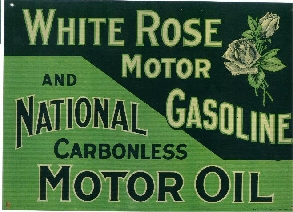 It
is interesting to me that a company with a product called "White
Rose Motor Gasoline" would not have made better use of a "rose" logo.The
tin sign (above) and the barrel at the top of the page are the only examples
I can find where they incorporated a image of the flower. I have a 1912
postcard which helps date this era.
It
is interesting to me that a company with a product called "White
Rose Motor Gasoline" would not have made better use of a "rose" logo.The
tin sign (above) and the barrel at the top of the page are the only examples
I can find where they incorporated a image of the flower. I have a 1912
postcard which helps date this era.
Several different logos for other petroleum
products were used but the "Boy and Slate", with his 1917 patent date,
would soon become the gasoline logo of choice ---for many years to come.
*The "White Rose " brand name only applied
to gasoline.*
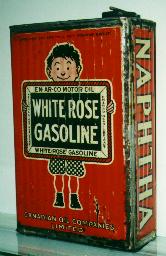
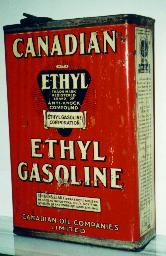
1925
A "new" dealer publication
called En-ar-co Booster appeared
in May 1925 .These newspaper style publications
were issued monthly and are my best reference material for this period.Besides
supplying dealers with the Boy's messages ( called En-ar-co-grams)
they were filled with new
product information , dealer testimonials and station
photographs. In 1925 photos, a few pre-visible
pumps are shown but I can not make out the globes. They
do not appear to use the Boy and Slate.
Early globes may have been a generic 1pc. milk-glass
or metal band type with just the word
"Gasoline", or a slogan of the pump
manufacturer.
I suspect these were supplied by the pump manufacturer
and not issued by the oil company.
* Do you have a photo of an earlier Canadian Oil
Co. globe that you could share on this page?
wpf@mnsi.net
1926

 By the summer issues ,dealers begin mentioning
increased business due to their "new" visible
By the summer issues ,dealers begin mentioning
increased business due to their "new" visible
gas pumps.Red Seal Gasoline is introduced to compete
with lower priced brands.Pump photos
clearly show only the metal band type Boy
and Slate /White Rose Gasoline and Red Seal globes
for the next few years. I have seen Red Seal with
both 15" and 16" dia. glass faces. These early
gas pumps photos show no signs or decals but had the
words "White Rose" or "Red Seal" hand
painted or stenciled , usually vertically , on the pump
skirts.
* All globe photos with the blue backdrop courtesy
of Noel Hamer *
1927
Two dealer testimonials in the April
1927 En-ar-co Booster extol the virtues of White
Rose Gasoline for dry-cleaning purposes--YIKES !
A 1911 ad reads;
Use White Rose Gasoline for cleaning purposes.It
will not leave any greasy carbons in the cloth or
silk.
1929
In Sept. 1929 National Refining Company signed
an agreement with the Ethyl Corporation (1923)
to use their process of adding lead
(tetraethyl-- lead) to gasoline.
1930
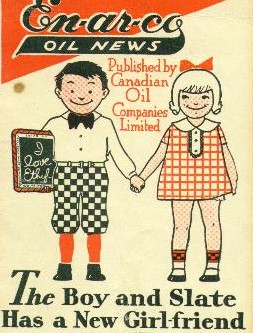 The March 1930 En-ar-co Booster
and En-ar-co Oil News booklet introduces the newest
The March 1930 En-ar-co Booster
and En-ar-co Oil News booklet introduces the newest
member of the White Rose family --- Canadian Ethyl
Gasoline.
It appears to me that this is
the time Canadian Oil Companies Limited began using one piece
milk-glass globes on their pumps.All previous photographs
that I have show the metal band type
globes.
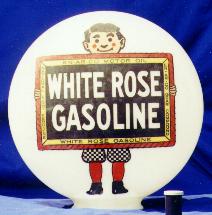

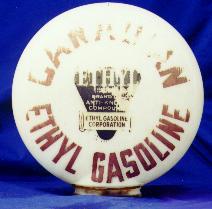 One piece milk glass globes, as well as
the metal band type globes, were now available for
One piece milk glass globes, as well as
the metal band type globes, were now available for
White Rose , Red Seal and Canadian Ethyl Gasoline
.
Canadian globes were produced by at
least two, possibly three manufacturers and this could
explain some variations in graphics and styles.One piece
milk glass and metal band globes
overlapped in their usage , possibly depending on current
market price , geographic location of the
station or dealer preference.
Close examination of some one piece
globes will reveal a date , embossed in the glass-- on the
inside , near the base .
Original glass faces for metal band globes
were not dated -- but the earlier versions have
the
vertical wording on the edge of the slate. (National
Light Kerosene and En-Ar-Co Gear Compound)
An ex-employee of a globe manufacturer recalls
a common practice of buffing to remove the logo
of Red Seal one piece globes
and re-lettering them with the Boy and Slate logo. I have seen
examples of these where the Red Seal image is still visible
if viewed at the right angle.
1932
Canadian Ethyl Gasoline
was now promoted as "Red in color". Note the American influence
here ,as I was taught the Canadian spelling "colour".
White Rose Gasoline was described as
"uncolored".
I believe various amounts of tetraethyl
lead were used in all grades of gasoline as an octane
booster. Hence the "Contains Lead" signs could be found on the pumps of
all grades of gasoline
1933
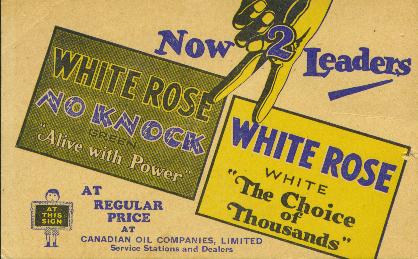 I believe this blotter and a similar
envelope in my collection , postmarked July 1933 date the
introduction of White Rose No-Knock Gasoline. Notice that White
Rose No-Knock Gasoline is
I believe this blotter and a similar
envelope in my collection , postmarked July 1933 date the
introduction of White Rose No-Knock Gasoline. Notice that White
Rose No-Knock Gasoline is
called "green" , suggesting the green dye , used to identify
specific grades in the visible gas pumps.
Remember that Canadian Ethyl Gasoline
is "red" , while White Rose Gasoline is called"white",
presumably still "not colored".
Although the National Refining
Company also produced WHITE ROSE GASOLINE ,
WHITE ROSE NO-KNOCK
was exclusively a Canadian product.
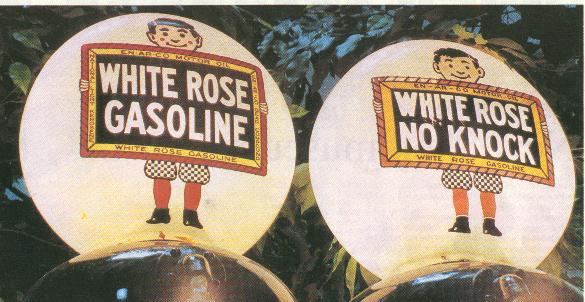 Here are two one-piece globes (thanks
to Ron Carey) of this era. Notice the vertical lettering on the
side
of the earlier "Gasoline" globe (1930) which is noticeably
absent on the newer "No-Knock" version (1934).
Also new is a slight different face for the "boy" , with
his hair parted on the opposite side.This "look" is quite
rare.
Here are two one-piece globes (thanks
to Ron Carey) of this era. Notice the vertical lettering on the
side
of the earlier "Gasoline" globe (1930) which is noticeably
absent on the newer "No-Knock" version (1934).
Also new is a slight different face for the "boy" , with
his hair parted on the opposite side.This "look" is quite
rare.
1934-1939
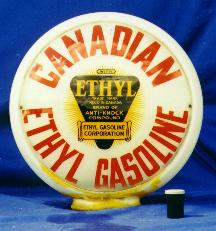
 My reference
library is quite skimpy for these years. I suspect the depression and lean
My reference
library is quite skimpy for these years. I suspect the depression and lean
times for the parent National
Refining Company lead to a reduction in the amount of advertising
.
What info I have been able to find, suggests that late
in the 1930's Canadian Oil Companies Ltd.
began to use the "new " 3-piece
glass , wide bodied globes , with 13 1/2" dia. glass face plates.
Later a switch was made to the narrow body globe
.
Three grades of
gasoline were produced
"Canadian Ethyl Gasoline "
(globe as shown above)
"White Rose No-Knock Gasoline "
(No-knock in white letters) --- (70 octane)
"White Rose Gasoline"
(Gasoline in white letters) --- (not shown)
* Notice the absence of the vertical lettering on the sides of the slate,
and the words "White Rose in the yellow border of the slate. This will
soon change !
There was also a similar ad-glass available
for all gas pumps so equipped.These used a black background. (see
ad-glass photos at the bottom of this page)
* Do you have any additional information concerning this era?
wpf@mnsi.net
1939
Canadian Oil
Companies Limited returns to Canadian ownership
! (late 1938 actually)
Almost immediately the company grasped their un-used
asset---The image of a "rose".
The "White Rose"
brand and logo were implemented on almost the complete product line.
Fortunately they were permitted to carry on using the
"Boy and Slate" logo and used this in
conjunction with the "rose" during the transition years,
mainly on their printed advertising.
The "Boy and Slate" would
remain on the medium grade oil until 1952 and , likewise
the
"en-ar-co"
name, until the end came in 1967.

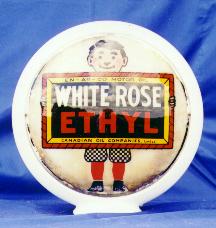 New globes continued
to use the Boy and Slate ,but with a few changes :
New globes continued
to use the Boy and Slate ,but with a few changes :
(1) The yellow border of the slate now says "Canadian Oil
Companies Limited "
(2) White Rose Ethyl replaces
Canadian Ethyl Gasoline
(3) Colour was added to the gasoline brand name on
the slate.
Undoubtedly there was some overlapping of
names , as a 11-38 invoice , which would have
been printed near the time of the Canadian purchase is
already pre-printed with:
White Rose Ethyl Gasoline
White Rose No-Knock Gasoline
White Rose Gasoline
while an order form (code dated 8-39) still shows
Canadian Ethyl Gasoline.
A later order form ( dated 10 - 41)
changes to the new White Rose Ethyl Gasoline ,
while White Rose Gasoline has
been dropped.
1940
In the summer
of 1940 the company issued a new dealer publication called
the White Rose News .I am fortunate to have a
complete set and used them to help research
much of the following information
1941
Invoices now show the Boy and Slate plus the
"rose" logo .
. * I believe the brand "White Rose Gasoline"
was discontinued by this point. *
Effective July 21,
1941, wartime gasoline and oil regulations ruled gasoline could not be
sold between the hours
of 7 P.M. and & 7 A.M. or
anytime on Sundays. Also it is now illegal for any dealer to offer premiums,loans,
gifts,
concessions or any benefits apart
from the normal services rendered by the dealer. (No More
Goodies !)
1942
A dealer invoice
shows Red Seal Gasoline is still available
New invoices have only the "Rose" logo.
1943
Along with wartime gasoline
rationing , gasoline now has a grade number ,
and octane ratings show up on pumps;
White Rose Ethyl Gasoline
Grade 1 , Octane 75
White Rose No-Knock Gasoline
Grade 2 , Octane 66
1946
 The Summer 1946 issue of the
White Rose News shows the first photo of the new
The Summer 1946 issue of the
White Rose News shows the first photo of the new
"circle rose" globe (center) that I can verify.
It is on the head table at the Managers Meeting,
leading me to suspect it was just being introduced.
Previous photos show the Boy and Slate globes.
I believe the narrow-body glass globes appearred at this
time.
The Fall 1947 issue of the White
Rose News has the first photos I have seen of the 3-piece
glass globe with White Rose Ethyl face plate
(right). The first was taken at the Dominion Day parade
(July 1) in Ridgetown, Ontario.
A second is shown on a gas pump, in the companies display, at the
Canadian National Exhibition in
Toronto.
(1)
in the photo above, the globe on the left has the words White
Rose at the top , and the
additional word Ethyl below
the logo.
( I have recently found a photo (1934) which shows me that this face plate
was used in
the U.S.A. on a wide-bodied globe, by National Refining Co. It is from
the era when
Canadian Oil Co. was using the Canadian Ethyl Gasoline globe. It
does however provide
a clue to the era of wide-bodied globes.)
(2)
the Canadian globe (right) uses the Ethyl Corp. logo , encircled
by the words White on top,
and Rose below. Text inside the Ethyl logo
denotes" Trademark registered in Canada".
* About 1942 (?) the name in the ethyl logo
changed from ETHYL GASOLINE CORPORATION
to simply ETHYL
CORPORATION. This might provide a clue help you to date your globes.
Note: this name change
and date may only apply in the U.S.A.
1950
Photos of the newest - company owned stations,
shown in the companies 1950 Annual Report,
no longer have globes on the gas pumps. While stations
may have continued using their old globes,
their days were numbered.
1952
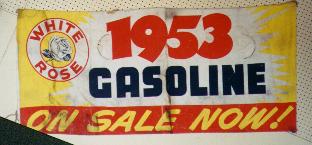 I have two pieces of memorabilia
, probably issued in 1952 ,advertising "1953 GASOLINE". Strangely
, these were printed with the soon to be out-dated circle-rose logo.
I have two pieces of memorabilia
, probably issued in 1952 ,advertising "1953 GASOLINE". Strangely
, these were printed with the soon to be out-dated circle-rose logo.
I have found no other mention of the "1953 GASOLINE"
promotion in any of 1952 or 1953
literature.
Gas pumps through the 40's and early
50's were yellow with a "circle rose" transfer (decal) ,
and an additional Ethyl transfer on those
pumps.
The base of these pumps were sometimes
painted green.
1953
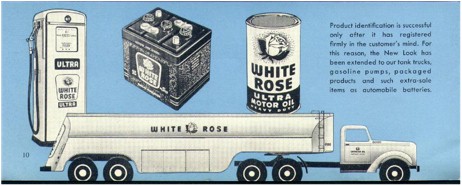 The New
Look ! In the companies own words ; "Our emblem
was re-designed into a
The New
Look ! In the companies own words ; "Our emblem
was re-designed into a
distinctive wedge shape, which achieves identification
at a glance---even from a distance."
Lots of other changes too! "In conjunction with the new
company emblem , new packages have
been designed for many of your companies products."
The New Look would included
the new "speckled rose" design on tank-trucks, signs, stationery,
oil tins, and pump transfers, and new product lines such
as White Rose Batteries. More important
to this article is the introduction of the new "ULTRA"
line of oils, grease and gasoline.
"ULTRA Gasoline" became the
new #1 grade and replaced White Rose Ethyl.
The "ULTRA" pump was white with a green base ,
no globe, but had a green ad-glass with
"ULTRA" in yellow block letters , and the new
"wedge" above an "ULTRA" transfer.
The "Ethyl" logo is dropped. (sample ad-glass
photos are shown at the bottom of this page)
Also, "White Rose No-Knock
Gasoline" was replaced with "White Rose Gasoline" It was
now dispensed from yellow pumps on a red base , and had
a red ad-glass with three images of
the white rose. They also used the
new wedge design transfer.
I appears, in photos, that the Ethyl logo is no
longer used on the gas pumps of this era
1955
This years annual report discusses their new ad campaign
featuring :
"CANADA'S HIGHEST OCTANE GASOLINE"
1958
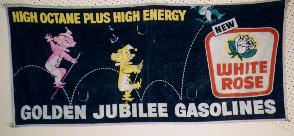 Brought about
a new ad program for "Golden Jubilee Gasolines", in celebration
of the
Brought about
a new ad program for "Golden Jubilee Gasolines", in celebration
of the
Companies 50th year in business. Coincidentally this
year also marked the 100th anniversary of
the first oil well in North America,
brought in by James Miller Williams in 1858 at Oil Springs,
Ontario.
This ad campaign was probably never
fully developed , as I have only seen it used on road maps
and a banner (above) in my collection.
1960
 White Rose "TOTAL GASOLINES"
are introduced May 20th, 1960.
White Rose "TOTAL GASOLINES"
are introduced May 20th, 1960.
The above scan came from a road
map. I have also seen it used with gas station window displays and billboards.There
was extensive advertising at the time , but I have very few examples in
my collection.
Canadian Oil Co's Ltd., since 1930
, had used tetraethyl lead in their gasolines as an octane
booster. In 1957 an expansion at the Sarnia , Ontario
refinery allowed increased production of toluene.
Perhaps to save the royalties to the Ethyl Corp.,or perhaps
seeing the writing on the wall (towards unleaded),
the company switched to toluene to enhance the octane rating.
Gas pump ad -glasses remain White
Rose GASOLINE and White Rose ULTRA Gasoline
but a "TOTAL"
decal is added above the wedge transfer.
The May-June 1960 issue of the White
Rose Dealer , dedicated to the introduction, presents this description:
"TOTAL GASOLINES have everything needed for the
cars of today and tomorrow.Name an
important additive or development presented in top brand
motor fuels during the past decade and you'll find ALL of them in
the new White Rose TOTAL GASOLINES."
" ---secret formula has a carburetor detergent,
fuel system de-icing qualities, anti-rust protection, a storage stabilizer,
oxidation and gum retardent, spark plug fouling preventer, control of pre-ignition
factors, refined toluene component."
1963
Shell Canada purchases Canadian Oil Companies
Limited. The White Rose name would slowly
be phased out over a five year period.
1966
I have a farm dealer invoice (date code
1966) that shows Red Seal Gasoline was still available,
probably for tractors, along with White Rose Gasoline
and White Rose ULTRA Gasoline.
1967
White Rose Gasolines --
gone--- but not forgotten !
 Don't forget to visit the "monthly
feature" on
Ad-glass Samples
(not
in order)
Don't forget to visit the "monthly
feature" on
Ad-glass Samples
(not
in order)
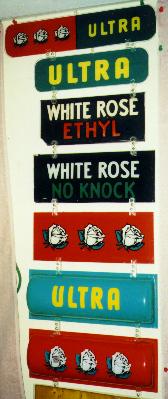 e-mail--
wpf@mnsi.net
| En-Ar-Co
/ White Rose |
e-mail--
wpf@mnsi.net
| En-Ar-Co
/ White Rose |























